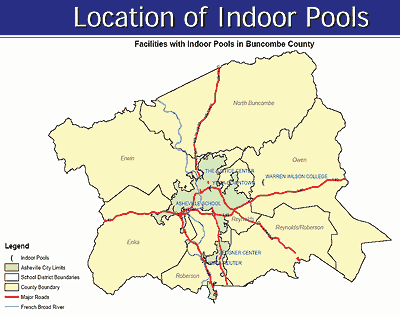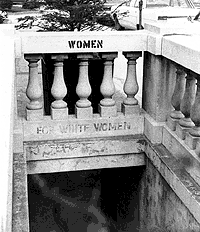On Feb. 5, the Buncombe County Board of Commissioners once again postponed a decision on helping fund a proposed 9-acre park linking the Haw Creek neighborhood to the Blue Ridge Parkway.
But unlike the board’s Jan. 22 meeting, when the commissioners were split on the issue and neighborhood residents were vocally unhappy with the decision, this time both sides favored a delay.

The sudden sense of cooperation was aided by County Manager Wanda Greene‘s having persuaded the property’s owners to take it off the market for 90 days until the commissioners could reach a decision. That eased one of park proponents’ major worries—that a developer would snap up the parcel before the county decided whether to kick in $250,000 (one-third of the asking price).
“This window of opportunity provides us time to assemble a funding package without another buyer undercutting our efforts,” Chris Pelly, president of the Haw Creek Community Association, told the board. “We are also in conversations with the city and county managers to find an approved appraisal.”
In addition, noted Pelly, the residents wanted to hold off until the full board was present. Commissioner Bill Stanley was out of town but hoped to return by the time the appraisal was finished.
Under the association’s proposal, the residents would raise one-third of the cost, with the city of Asheville (which has already approved its contribution, pending an appraisal) and the county each providing a matching amount. The city would maintain the park.
The original delay had been intended to give the county’s park-and-recreation staff and advisory board time to review the proposal, and neighborhood resident Dwayne Stutzman presented a letter from the advisory board.
“We believe the connection with the Mountains-to-Sea Trail is very meaningful, as is the proximity [to] the Blue Ridge Parkway, the remaining natural landscape, and the percentage of funds pledged toward the purchase price,” the letter states.
If the county approves its portion of the funding, the association will be able to close on the property, even though it hasn’t yet raised the residents’ entire share, said resident Terry Latanich.
Another change came when Vice Chair David Gantt, who had previously opposed postponing the county’s decision, made the motion to hold off again. “I’d like to direct that we get this appraisal done and then we bring this back up for a vote,” he said.
The motion was unanimously approved.
“A heck of an investment”
The county has substantial parks-and-recreation needs: new facilities, an aquatic center for indoor swimming, a central headquarters for its staff (which also needs to be increased) and a full-time director, Fran Thigpen told the board.
You must remember this
by Kent Priestley
Many view Asheville as a place of tolerance, but this wasn’t always the case. As late as the 1970s, the city still bore visible scars of Jim Crow’s ugly reign. The enforced divisions in American society are attested to in Andrea Clark‘s photographs of Asheville from the early 1970s, including an image of an underground restroom at Pack Square bearing the words “For White Women” in faded letters.

“As far as we know, she was the only one to record the evidence of segregation in the city on film,” says Karen Loughmiller, Adult Programs Librarian at the West Asheville Public Library.
Loughmiller saw a need to preserve memories of Asheville from before the Civil Rights era, and last spring organized “I Remember Jim Crow,” a roundtable of personal narratives from African-American seniors. Speakers at the event included Stephens-Lee High School alumna Lucille Flack Ray, Ruby Rice Jones, Elinor Brown Earle and Pat Brown Griffin. Clark’s telling photographs were also exhibited.
The program garnered an award from the North Carolina Public Library Directors Association in the “best adult program” category for a large public library for 2007, a distinction noted by the Buncombe County Board of Commissioners at its Feb. 5 meeting.
“It struck a nerve,” says Buncombe County Library Director Ed Sheary of “I Remember Jim Crow.” “There was a lot of feeling that we need to talk about this before the people who experienced it are gone.”
Thanks to Loughmiller’s foresight, a CD of the program was made, so the memories will live on well after those who endured the shame of segregation have passed on.
“While Asheville has never really projected an image as a Southern city, some of the bad elements of the Old South were very much here,” Sheary says. “It’s hard to believe that people here were treated so badly, so recently.”
“We’re talking about a really big plan—there’s nothing small about what we’re bringing you today,” said Thigpen, the agency’s current part-time director. “We’re bringing you a lot of big ideas; we’re bringing you a lot of big hopes; we’re bringing you something that would take a heck of an investment: a big investment for Buncombe County and for tourism.”
Although most of the proposals don’t have definite price tags yet, one major item calls for upping the staffing budget by 50 percent, from $200,000 to $300,000 per year.
Among other things, the report highlights the county’s relative shortage of such amenities as soccer fields, indoor swimming pools and softball fields, compared to other areas. One example cited—a Florida facility containing five softball fields—prompted Commissioner David Young to note, “There’s not that much flat land in Buncombe County.”
Thigpen said the parks-and-rec staff is looking at ways to realize such ambitious proposals without raising taxes, such as grants.
“We believe there are ways to pay for this,” she said. “Experience has shown that people will pay for good recreational facilities.”
Praising staff for having “done their homework,” Gantt declared: “We’re never going to hit the bull’s-eye unless we have a target. Every year, we need to review this and see how we can do [it]. I think we can. … Every time we go out on public comment, we hear we need facilities. We all know that’s what we have to do.”
During the public-comment period, multiple speakers emphasized the need for better swimming pools, asserting that not having them is hurting the county financially.
“An aquatic center is a wonderful idea,” self-described “swim parent” Jackie Rusco told the board. “There were 1,156 swimmers at the last meet in Knoxville. Add parents and you’ve got over 3,000 people buying food and staying in hotels. All our money is going to other counties.”
But Enka resident Jerry Rice urged the county to focus first on higher-priority items. “I like parks and sports fields, but we’ve got problems in this county we need to tackle before we worry about parks,” he said.
The board voted unanimously to accept the report and incorporate its proposals into their future planning.
Other business
The board also heard a report from the Land-of-Sky Regional Council’s adult-care-homes oversight staff, who said more volunteers are needed. Although Buncombe County has 69 adult-home-care units—more than any other county in the state—there are not enough volunteers and staff to oversee them, said Barbara Henshaw, Land-of-Sky’s long-term-care ombudsman.
In addition, the commissioners appointed Mike Goodson and L.C. Ray to the Board of Health.



Return the $250,000 to the taxpayers! We are surrounded by parkland.
We are surrounded by unmanaged development that was park land. I live in Haw Creek, love the neighborhood, and think that you can’t put a value on a public park. It increases property value, gives kids a place to play, and makes a place where communities can gather for fellowship. $250,000 is a steal, and a fraction of the city’s budget. Falstaff, if you hate parks, move back to Pittsburgh!